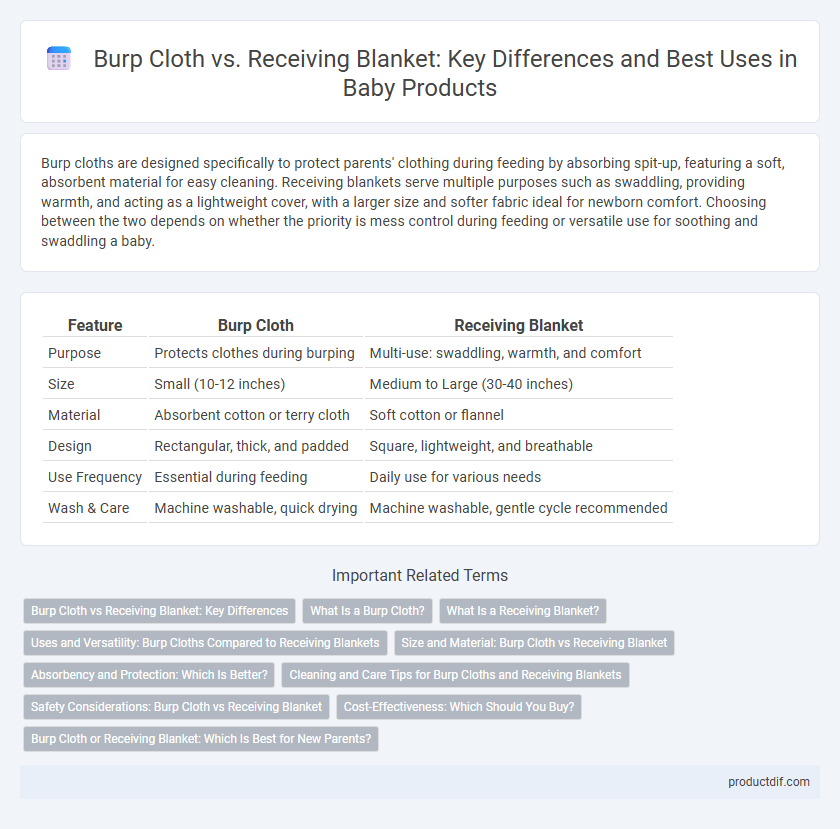Burp cloths are designed specifically to protect parents' clothing during feeding by absorbing spit-up, featuring a soft, absorbent material for easy cleaning. Receiving blankets serve multiple purposes such as swaddling, providing warmth, and acting as a lightweight cover, with a larger size and softer fabric ideal for newborn comfort. Choosing between the two depends on whether the priority is mess control during feeding or versatile use for soothing and swaddling a baby.
Table of Comparison
| Feature | Burp Cloth | Receiving Blanket |
|---|---|---|
| Purpose | Protects clothes during burping | Multi-use: swaddling, warmth, and comfort |
| Size | Small (10-12 inches) | Medium to Large (30-40 inches) |
| Material | Absorbent cotton or terry cloth | Soft cotton or flannel |
| Design | Rectangular, thick, and padded | Square, lightweight, and breathable |
| Use Frequency | Essential during feeding | Daily use for various needs |
| Wash & Care | Machine washable, quick drying | Machine washable, gentle cycle recommended |
Burp Cloth vs Receiving Blanket: Key Differences
Burp cloths are specifically designed for protecting clothing during feeding by absorbing spit-up and drool, featuring smaller, more absorbent fabrics that are easy to wash and carry. Receiving blankets serve multiple purposes including swaddling, providing warmth, and offering a soft surface for the baby, often made from lightweight, breathable materials larger in size than burp cloths. The main differences lie in their size, primary function, and material thickness--burp cloths prioritize absorbency and portability, while receiving blankets focus on comfort and versatility.
What Is a Burp Cloth?
A burp cloth is a small, absorbent fabric designed to protect parents' clothing while burping a baby, effectively catching spit-up and drool. Made from soft, breathable materials like cotton or muslin, burp cloths provide gentle contact on a baby's delicate skin. Unlike receiving blankets, which are larger and multipurpose, burp cloths serve a specific function during feeding and burping times.
What Is a Receiving Blanket?
A receiving blanket is a lightweight, soft cotton square designed primarily for swaddling, burping, and wrapping newborns. It measures around 30x30 inches, offering versatile uses such as a stroller cover, nursing cover, or clean surface for diaper changes. Unlike heavier burp cloths, receiving blankets provide breathable comfort while gently securing infants.
Uses and Versatility: Burp Cloths Compared to Receiving Blankets
Burp cloths are specifically designed for protecting parents' clothing during feeding, offering absorbent, compact sizes ideal for catching spit-up and drool. Receiving blankets serve multiple purposes beyond burping, including swaddling, providing warmth, and acting as a soft surface for changing or cuddling. The versatility of receiving blankets makes them valuable for everyday use, while burp cloths excel in targeted functionality focused on feeding times.
Size and Material: Burp Cloth vs Receiving Blanket
Burp cloths are typically smaller, measuring around 10x20 inches, designed for quick cleanups and made from absorbent materials like cotton terry or muslin to handle spit-up efficiently. Receiving blankets are larger, usually 30x40 inches, crafted from soft fabrics such as flannel or lightweight cotton to provide warmth and swaddling for newborns. The size and material differences reflect their distinct functions: burp cloths prioritize absorbency and ease of use, while receiving blankets emphasize comfort and coverage.
Absorbency and Protection: Which Is Better?
Burp cloths are specifically designed with high absorbency to handle spit-up and drool, featuring thick, layered fabrics that protect baby clothes effectively during feeding. Receiving blankets, while soft and versatile, generally offer less absorbency and serve more for warmth and swaddling rather than protecting clothing from moisture. For optimal protection against messes, burp cloths provide superior absorbency compared to receiving blankets.
Cleaning and Care Tips for Burp Cloths and Receiving Blankets
Burp cloths require frequent washing due to frequent contact with spit-up, and should be cleaned in warm water with a gentle detergent to maintain softness and absorbency. Receiving blankets, often made from cotton or muslin, benefit from gentle washing cycles and air drying to preserve fabric integrity and prevent shrinkage. Both items should be regularly inspected for stains and residue, avoiding bleach to prevent fabric damage and ensure baby-safe hygiene.
Safety Considerations: Burp Cloth vs Receiving Blanket
Burp cloths are designed with absorbent materials and smaller dimensions to ensure quick cleanup of spit-up while minimizing suffocation risks, making them safer for immediate use during feeding. Receiving blankets, often larger and made of lighter fabrics, provide warmth and comfort but require careful supervision to prevent accidental covering of a baby's face, posing a potential hazard. Choosing the appropriate fabric and size for each item enhances safety, with burp cloths prioritized for feeding times and receiving blankets for swaddling or supervised rest.
Cost-Effectiveness: Which Should You Buy?
Burp cloths offer a cost-effective solution for managing spit-up and drool with easy-to-wash, absorbent materials designed specifically for quick cleanups. Receiving blankets serve multiple purposes including swaddling, light covering, and tummy time, making them a versatile investment that can replace several baby products. Choosing burp cloths is ideal for focused mess control, while receiving blankets provide broader functionality, influencing their overall value depending on your baby care needs.
Burp Cloth or Receiving Blanket: Which Is Best for New Parents?
Burp cloths offer targeted protection against spit-up with their absorbent and easy-to-clean fabric, making them essential for feeding sessions. Receiving blankets provide versatile use, such as swaddling, warmth, and comfort, but may not absorb moisture as efficiently as burp cloths. New parents benefit from using both, yet burp cloths are preferable for managing messes during feeding, while receiving blankets serve broader purposes in newborn care.
Burp Cloth vs Receiving Blanket Infographic

 productdif.com
productdif.com